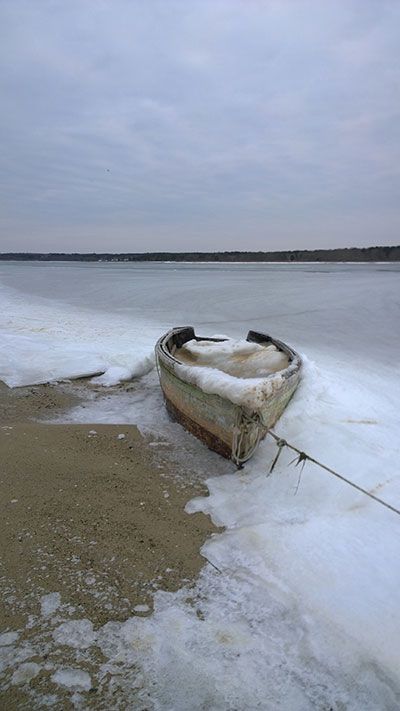

By Susan Wilson
Guest Columnist
Oak Bluffs, MA, USA

Susan Wilson
(credit: Mark Alan Lovewell)
In the milky light of dawn she is suspended, a creature of both water and sky. Her pale green reflection is a perfect mirror image in the still water; a slight rocking, like gentle breathing, substantiates her. Her name, they say, is Cassandra. She is aged. The beautiful lines that once defined her purpose are scabby with marine detritus, the tight seaworthiness of her bones is lost to the loosening of time and use. Where she once served, she now languishes, adrift but not free.
Maybe it's a divot in my psyche, or a developmental tic, but, whatever it is, I have a tendency to see the metaphor in small things. Some might say that it's a result of my years of writing novels, where a good metaphor or clever symbolism properly used can link seemingly random plot lines into a cohesive whole, but I think that seeing the metaphor is a natural quirk of mine that plays into the business of using my imagination for a living. I mention this because for a long time I watched the rise and fall of a small rowboat through all kinds of weather and sea conditions and wanted to apply a right and proper metaphor to it.
Almost every morning I drive along one of the most beautiful stretches of state owned road in the world, Beach Road from Oak Bluffs to Edgartown. On the left is Nantucket Sound, shimmering in the rising sun. To the left, the tidal salt pond, Sengekontaket. At just the right bend in the road, where the low rosa rugosa bushes give way to sand, I kept watch on a barnacle-encrusted old wooden rowboat of the kind that is used for work, not pleasure. What caught my eye initially was how perfectly the faded green of the hull matched the color of the water on that particular über still morning when I first noticed her. More than floating, the boat appeared to hover above the water, ethereal. In the evening, she was perfect against a red sky sunset, the change in palette transforming her from ethereal to substantial. From mythical creature to workhorse.

One morning, the little boat was gone. Her absence was curious as she certainly didn't look seaworthy and I couldn't believe that she was being used. I wished that I'd taken her picture, because, certainly, she'd been removed. It took a few trips down the road to figure out that she was still there. We'd had some bad weather and the combination of rain and leakiness had filled the flat-bottomed boat and she'd sunk under the weight. I was strangely saddened by the idea that this picturesque little workboat was gone and doubly regretted my failure to take her picture. Then, a curious thing happened. Day by day, more and more of her began to reappear, first the coaming of her gunnels, a hint of her bow nosing up. Then, a slow reemergence until she floated free. Holy cow, I thought, there's a metaphor in that. Again I squandered the opportunity to photograph her. When the full moon-conducted tides were extremely high and the corresponding low tides to the opposite extreme, the little boat alternately bobbed free and then sank under the weight of water. She would reappear flat on her belly in the mud, rising only as the phases of the moon waxed and the high water would finally reach her, lifting her up off the beach. Less aggressive phases of the moon and she'd sink in deeper water, to emerge a week or two later. Resurrected.

Okay, what do I do with that perfect image of resurrection? As a Christian, the natural association might be with Jesus' emergence from the tomb after three days. As a writer, I think more about the emergence of a character's spirit, or, perhaps his or her hope. Or faith. Or maybe a sign of the end of a journey. Lots of good old spiritual tropes suggest themselves. I could weave the image of the rising boat into a story of rising to a challenge; her disappearance into a symbol of the depths of despair. I thought of my work-in-progress, I thought about how my characters needed to grow and develop and overcome history. But the little boat's particular situation wasn't easily modified to fit the story, unless I wanted to create some anguished simile and that was out of the question.
I finally began to photograph her, stopping along Beach Road on mornings when her aged beauty was watercolor magic in the rising sun; or, when the sunset colored the opposite shore and provided a perfect backdrop as she floated free.

It was, for this place, one of the worst winters on record. Ice, snow, wind, bitter cold in a place that boasts about enjoying a temperate climate for New England. When we are asked about our winters, about how much snow we typically get, we say: Sure, for a day or two then it melts. Except that last year the snow never went away. As the carol says, snow fell, snow upon snow from December to March. Bitter cold descended and kept us in its grip, and the surface of the salt pond froze, the plaques of ice undulating like some kind of gigantic Slushy as the free water moved beneath them.
At some point I noticed that the little resurrection boat had crawled onto the beach, yards away from the edge of the ice. At first I figured that someone had taken pity on the poor thing and gotten her out of the water before she was crushed by the ice. But now I don't think that was the case. I think the ice pushed her up, then receded enough that she was left on shore. The snow filled her, the frozen spray lacquered her gunnels and bow, fringed her painter, still tied to the mushroom anchor, itself up on the beach. There was no hope of her getting back into her natural environment and I thought that she'd end her days beached forever on shore.

Every day I drove by, the little boat remained safe on shore. Then, to use a fresh simile, like a glacier, she began to crawl toward the water's edge. I have to admit, it kind of freaked me out. From nearly parallel with the shoreline, she'd turned her bow to point to the water. Little by little, she got nearer to the water's edge. Finally, by late spring, she had made her way close enough that with the first full moon tide, she was, once again, afloat. She wasn't ready to be a land creature. She was born to live upon the water, or beneath it, and that's where she returned.
As a writer who anthropomorphizes the inner thoughts of dogs, it was pretty easy for me to see this little boat as something with a soul. A will. A desire to survive. There is a reason sailors refer to boats in the feminine, of having a will of their own. This rowboat of uncertain parentage, of neglectful ownership, was very alive to me, and I finally figured it out, she wasn't meant to be the metaphor, she was the character, not the symbol, but the story.
This spring she was moved, this time by human hands, and took up residence close to the boat ramp where she continued to sink and swim. And then she was really and truly gone. Because I live in a small place with its own Facebook page, I threw the question out there, did anyone know what had happened to her. Turns out, I wasn't the only one keeping tabs on the little boat. I learned that her name was Cassandra, that she was likely built more than thirty years ago by a man named James, and that, as I had been, local folk had been photographing her and rooting for her and also wondering as to her whereabouts. I finally heard that someone has her, and is giving her the TLC that she deserves. That's a pretty good ending for the story, that the old girl will soon swing on her painter, free and beautiful once more, perhaps even be put back to work. Oddly enough, I'm a little disappointed. If she no longer slips beneath the surface, no longer rises to a new life, will she be something entirely different? Will the symbolism of her become that of reincarnation, not resurrection? And where do I go with that?
Link:





